| Article ID | Journal | Published Year | Pages | File Type |
|---|---|---|---|---|
| 2907452 | Cirugía Cardiovascular | 2012 | 5 Pages |
ResuménCon la introducción en 1953 de la circulación extracorpórea (CEC) se inició la historia de la cirugía cardíaca abierta, y las lesiones regurgitantes valvulares pudieron ser tratadas. En 1965 Kay diseñó una estrategia novedosa para reparar la insuficiencia tricúspide (IT), pero no fue realmente hasta 1972 cuando de Vega describió su técnica de anuloplastia, definiéndola como selectiva, regulable y permanente. Por esta misma época, Carpentier inventó el anillo que lleva su nombre, y probablemente todo parecía indicar que al menos la enfermedad adquirida de la válvula tricúspide (VT) estaba en camino de ser quirúrgicamente resuelta. En este medio siglo, y después de múltiples autoplastias de sutura y múltiples anillos, completos, incompletos, rígidos, flexibles e incluso tridimensionales, puede parecer que aquel entusiasmo se ha desvanecido.Es posible que ni el exceso de certeza inicial ni la desconfianza de la actualidad sean unas actitudes lógicas, porque probablemente la incógnita pueda despejarse aplicando la teoría de las manzanas y las peras.
In 1953 the use of the cardiopulmonary bypass was responsible for the beginning of the history of open-heart surgery and regurgitant lesions of the heart valves could be treated. Kay, in 1965, designed a novel strategy to repair tricuspid insufficiency, but it wasn't until 1972 that de Vega described his technique of selective, adjustable, and permanent annuloplasty. Around the same time, Carpentier invented the ring that bears his name and probably everything seemed to indicate that at least the acquired pathology of the tricuspid valve was on track to be resolved surgically. since then, with multiple suture annuloplasties and numerous types of rings, complete, incomplete, rigid, flexible, and even three-dimensional rings, it may seem that the initial enthusiasm is vanishing.It is possible that neither the initial confidence nor skepticism of today are logical attitudes, because probably the unknown can be cleared by applying the theory of comparing apples and pears.
